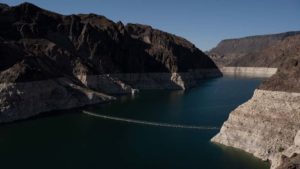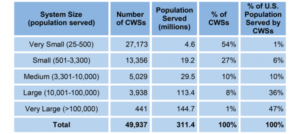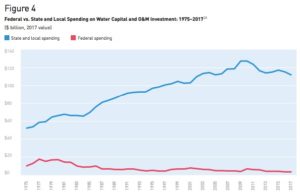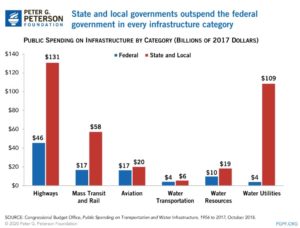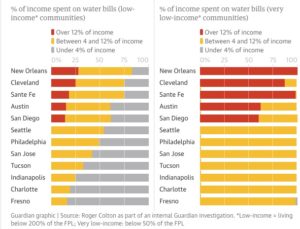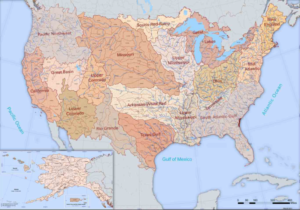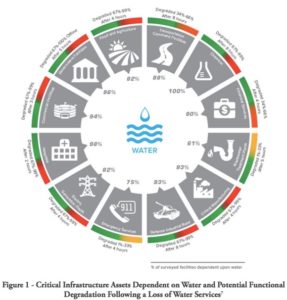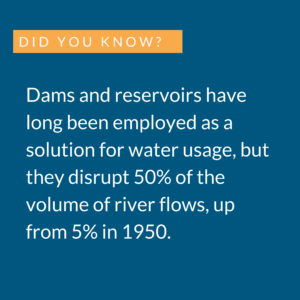When we turn on the tap or buy bottled water, we don’t normally consider where it comes from. Water affects almost every aspect of our lives, from staying hydrated and flushing toilets to putting out fires and growing food. How does the water system work? Who are the major influencers? What is the state of water infrastructure in the U.S.? How do we combat droughts, floods, and pollution? How do we value an invaluable resource and make it accessible for all?
Introduction
View the Executive Summary
Case Study
In August 2021, the federal government for the first time declared a water shortage at Lake Mead, which is the reservoir of the Hoover Dam and the largest reservoir on the Colorado River. Water levels dropped below 40% of capacity, due to hot temperatures and reduced spring snowmelt from the Rockies. The entire Colorado River system, which serves 40 million people across seven U.S. states and two states in Mexico, is at half capacity. The image below shows the high-water mark known as the “bathtub ring,” demonstrating how much water levels have fallen at Lake Mead.
Lake Mead is crucial to the water supply for 25 million people in cities including Los Angeles, San Diego, Phoenix, Tucson, and Las Vegas. The Hoover Dam also provides power to 1.3 million people in Nevada, Arizona, and California, and low water levels have decreased efficiency by 25%. The drought proclamation will “prompt a reduction in water releases to Arizona, Nevada and Mexico in 2022 to make sure there is enough water in the reservoir to keep generating power and provide water for essential uses.” Arizona is estimated to lose 18% of its share from the river and Nevada to lose 7% of its allocation. Household water supplies will not be affected, but prices likely will be.
California has already been in this situation for years, and in October 2021 Governor Gavin Newsom expanded the California drought emergency to the entire state. The U.S. Bureau of Reclamation, which manages U.S. water resources, cut water allocation for many California farmers to zero for 2021 and 2022. Some are turning to the private market, where they could pay as much as four times what the government typically charges. When drought conditions were most severe in 2014-2015, total farm-related losses in California totaled $5 billion and 20,000 individuals lost jobs, according to the Center for Watershed Sciences at the University of California, Davis.
The U.S. Bureau of Reclamation notes the Western U.S. is going through the driest period in the 115 years of the Bureau’s record-keeping. Thanks to a warming climate and the La Niña weather pattern, drought is affecting 88% of the American West, up from 40% during the summer of 2020.
See maps from Visual Capitalist on U.S. Droughts Over the Last 20 Years, and the U.S. Drought Monitor.
Why It Matters
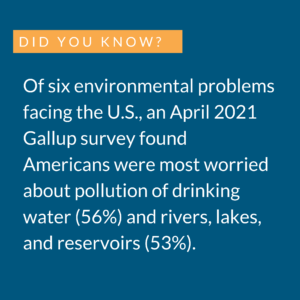 In the 20th century, communities focused on generating and distributing water in a safe, reliable and affordable way. In the 21st century, America still faces water access, affordability, availability, and infrastructure challenges. The American Society of Civil Engineers gives the U.S. water infrastructure a grade of D, meaning the infrastructure is “mostly below standard,” and “[c]ondition and capacity are of serious concern with strong risk of failure.” Added to these concerns are the difficulties and uncertainties posed by the climate, as well as worries about conservation, contamination, and resilience. Water affects everything from food production to national security to energy consumption. As citizens, we have a responsibility to engage constructively with our representatives at all levels of government to ensure we avoid a major crisis; have reliable access to clean, safe water; and innovate to conserve water for future generations.
In the 20th century, communities focused on generating and distributing water in a safe, reliable and affordable way. In the 21st century, America still faces water access, affordability, availability, and infrastructure challenges. The American Society of Civil Engineers gives the U.S. water infrastructure a grade of D, meaning the infrastructure is “mostly below standard,” and “[c]ondition and capacity are of serious concern with strong risk of failure.” Added to these concerns are the difficulties and uncertainties posed by the climate, as well as worries about conservation, contamination, and resilience. Water affects everything from food production to national security to energy consumption. As citizens, we have a responsibility to engage constructively with our representatives at all levels of government to ensure we avoid a major crisis; have reliable access to clean, safe water; and innovate to conserve water for future generations.
Putting it in Context
History
Civilization depends on water. The Roman system of aqueducts and underground pipes was the first sewer network, and serves as the basis of modern water systems, including that of the U.S.
In the 1800s, the U.S. water infrastructure consisted of wells and small reservoirs. Population increases in cities like New York, Boston, Washington, and Philadelphia overwhelmed local water supplies, prompting leaders to invest in expanded canals, pipes, and reservoirs. Cities on the west coast followed suit, and the construction of dams and reservoirs helped westward migration.
The next crisis was the resulting waste. Sewage produced by cities flowed to rivers that served as the drinking water supply for the cities downstream. By the late 1800s, waterborne diseases were the leading cause of death in the U.S. Billions of dollars of government investments in treatment plants in the early 1900s mostly eradicated water- and sanitation-related diseases. Federal support to build water systems continued through the early 1900s and after World War II with many Great Society initiatives. Between 1950 and 1970, the percentage of the population without complete plumbing fell from 27% to 6%.
Between 1972 and 1992, the federal government invested over $60 billion ($700 per person in today’s dollars) in waterways. Today, federal funding is only a small percentage of what it was, having fallen by almost 80%. In 2019, total capital spending on water infrastructure at the local, state, and federal levels was $48 billion.
The Modern Water System
The water system includes:
- Drinking water and wastewater treatment plants
- Storage facilities
- Distribution systems, including pipes, that convey drinking water
There are roughly 200,000 drinking water treatment systems in the U.S. Some are privately owned, but most (over 150,000) are run by public agencies. These provide 90% of Americans with potable water. Public drinking water systems are regulated by the EPA and management is delegated to states, municipalities, and tribes. Rates are set by a local governing board.
The specific types of public water systems are:
- Community water systems (CWS) supply water to the same population year-round. Roughly ⅓ of public water systems in the U.S. are community systems, which distribute 39 billion gallons of potable water to homes, industries, and businesses daily. The following chart breaks down the number of CWSs and their size.
- Non-community water systems, which include transient and non-transient systems:
- Transient non-community water systems provide water but not to the same people or on a regular basis, such as to a campground.
- Non-transient non-community water systems provide water to schools, factories, office buildings, and hospitals.
Private or individual systems refer to private groundwater residential wells, cisterns, and larger private water systems that serve more than one residence. These systems serve over 36 million Americans and can be for-profit or managed by investors or shareholders. Rates are monitored by the state’s public commission but are not necessarily subject to a regulating board. EPA regulations that protect public drinking water systems do not apply to privately owned wells or other individual water systems.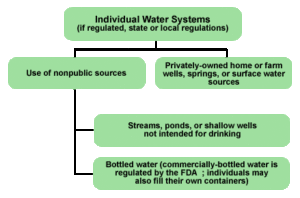
Wastewater treatment plants are also either publicly or privately owned. There are more than 16,000 publicly owned wastewater treatment systems in the U.S., which serve about 75% of the U.S. population. These systems collect and treat 32 billion gallons of wastewater daily. The rest of the population relies on private systems, such as septic tanks (20% of U.S. households).
By the Numbers
Access & Affordability
At least 2 million Americans do not have access to safe drinking water and sanitation. This includes 1.4 million Americans living in U.S. households; 250,000 Americans living in Puerto Rico; and 550,000 homeless Americans.
In 2019, more than 44 million Americans receiving water from community water systems were served by systems that had health-based Safe Drinking Water Act violations.
For private wells, which are not regulated by the EPA, data is not frequently collected. The most recent testing from the U.S. Geological Survey (the federal agency that conducts most water data collection) was in 2009. It found 23% of private wells in the U.S. tested positive for contaminants such as arsenic, uranium, nitrates, and E. coli.
Based on results from the American Community Survey, Black and Hispanic households are twice as likely as white households to lack complete indoor plumbing. Native American households are 19 times more likely than white households to lack complete indoor plumbing.
The Guardian reports an estimated 10% of Native American households lack access to safe tap water or basic sanitation. In the Navajo Nation, over one-third of residents do not have complete plumbing. On the Hopi reservation, 75% of residents only have access to water contaminated with elevated levels of arsenic and uranium due to mines that have leached toxins into groundwater.
For those who do have access, affordability can be an issue. The EPA standard for affordability is that households spend no more than 2% on drinking water and 4.5% of median household income on both drinking water and wastewater services. About 90% of Americans pay drinking water rates that are below the standard.
Usage
The average American uses between 80 and 100 gallons of water daily. The estimated total daily usage across the country tops 345 billion gallons. California and Texas account for 16% of U.S. water withdrawals. U.S. domestic water use per person actually fell 18% from 2000 to 2015, mostly due to national water efficiency standards that required plumbing manufacturers to reduce the volume of water used by toilets, faucets, and shower heads. Many utilities, especially in the West, also offer incentives for homeowners and businesses to use less water. Los Angeles’ population has grown by one million people since the 1970s, but water usage is still the same level thanks to water meters and careful pricing to discourage waste.
To compare U.S. annual water use to that of other countries, see this data set.
Interdependence of Energy and Water
The U.S. energy system is the largest consumer of water, requiring 58 trillion gallons of water withdrawals annually, enough to fill 88 million Olympic-size swimming pools. This amounts to about 40% of total water withdrawals in the country.
Power plants that generate electricity account for over 90% of energy-related water withdrawals. These power plants use natural gas, coal, and nuclear power, and require water mainly for cooling; wind and solar plants require very little water in comparison.
Oil and natural gas production and refineries consume 30% of all water consumed by energy sources. The Water Footprint Calculator estimates it takes 3 to 6 gallons of water to produce one gallon of gas. Eco-friendly biofuels, such as corn ethanol, require even more water, anywhere between 10 and 300 gallons of water for every gallon of fuel produced depending on the type.
Hydraulic fracturing, known as fracking, is an oil extraction technique using a pressurized mix of water and various chemicals to break up bedrock and access oil and gas deposits. Fracking has allowed the U.S. to domestically produce oil and natural gas, but comes with a trade-off of deciding to use freshwater for energy production or for human consumption. In 2018, North Dakota’s fracking industry produced 19 billion gallons of wastewater.
At the local level, energy consumed by public drinking water and wastewater utilities represents 30-40% of a municipality’s energy bill. This means energy costs can impact water prices.
Water Infrastructure and Water Loss
Among households, the EPA estimates that the average household wastes 180 gallons of water weekly due to leaks. This amounts to 9,400 gallons of water per household annually, which equates to about 300 loads of laundry. In sum, households leak 900 billion gallons of water, which is the annual use of nearly 11 million homes. 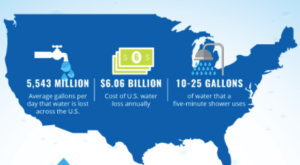
Among water utilities, a water main breaks every 2 minutes in the U.S. At least six billion gallons of treated water are lost daily due to leaks. The average U.S. water utility loses an estimated 16% of treated water due to leaks, but specific amounts depend on the infrastructure. Aging systems, such as in Chicago, can lose almost 30% of water; in 2016, an estimated 25 billion gallons of water drawn from Lake Michigan were lost due to leaking pipes.
These losses are not cheap. In St. Petersburg, Florida, the water loss rate of 15% in 2016 cost the city $3.4 million. The Water Quality and Health Council estimates it will take almost $100 billion in spending nationwide to control water loss over the next two decades.
Water Quality
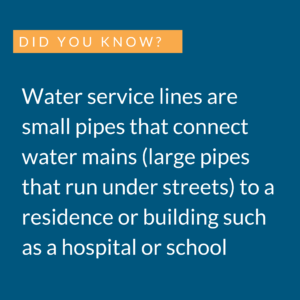 Lead poisoning was understood by the late 1800s, but the U.S. Water Alliance reports it was still approved in national model plumbing codes through the 1980s. There are an estimated 6 to 10 million lead service lines in communities across the country, affecting 30% of U.S. water systems. More than 2,000 cities across the U.S. have elevated levels of lead in their water supply, and 44% of schools have lead concentrations above standards for action. Full removal can cost between $1,200 and $12,300 per service line.
Lead poisoning was understood by the late 1800s, but the U.S. Water Alliance reports it was still approved in national model plumbing codes through the 1980s. There are an estimated 6 to 10 million lead service lines in communities across the country, affecting 30% of U.S. water systems. More than 2,000 cities across the U.S. have elevated levels of lead in their water supply, and 44% of schools have lead concentrations above standards for action. Full removal can cost between $1,200 and $12,300 per service line.
The Role of Government
The Spending Clause in the Constitution “gives Congress the power to ‘lay and collect Taxes, Duties, Imposts, and Excises, to pay the Debts and provide for the common Defence and the general Welfare of the United States.’” Access to water would fall under general welfare.
The EPA’s most recent Drinking Water Infrastructure Needs Survey and Assessment found U.S. water systems need $472 billion to continue providing clean and safe drinking water, including:
- $312 billion for the more than 2.2 million miles of transmission and distribution mains
- $83 billion for water treatment
- $47 billion for storage
- $22 billion for source development.
On an annual basis, the U.S. would need to invest $109 billion per year over the next 20 years to close the water infrastructure gap. Total needs in 2019 amounted to $129 billion, but spending on water infrastructure at the local, state, and federal levels came to $48 billion.
The $1 trillion infrastructure bill signed into legislation in November 2021 allocates $55 billion for water and wastewater infrastructure, including $15 billion to replace lead pipes. Based on the estimated cost of $4,700 to replace a lead service line and the estimate of 6 to 10 million lead service lines across the country, the cost to replace all lead service lines could range from $28 million to $48 million.
Federal
The federal government’s main role was originally providing assistance and funding for water resource development projects, such as the Hoover Dam. In the last few decades, legislation has focused on regulating water quality, protecting wildlife, and managing resources. Federal involvement in water resource development, management, protection, and use has grown more complex due to overlaps and gaps in resources, funding, and authorization.
Congress
The main Congressional Committees that address water-related issues include:
- House Subcommittee on Water Resources and Environment (under House Committee on Transportation & Infrastructure) which has jurisdiction over “matters relating to water resources development, conservation and management, water pollution control and water infrastructure, and hazardous waste clean up.”
- House Subcommittee on Water, Oceans, and Wildlife (under House Committee on Natural Resources), which “is responsible for overseeing the agencies that manage America’s water resources, hydropower development, and federal transmission lines.”
- Senate Subcommittee on Water and Power (under Senate Committee on Energy & Natural Resources), which has oversight of “irrigation; reclamation projects, including related flood control purposes; power marketing administrations… energy development impacts on water resources; groundwater resources and management; hydroelectric power; low head hydro; and energy related aspects of deepwater ports.”
- Senate Subcommittee on Fisheries, Water, and Wildlife (under Senate Committee on Environment and Public Works), which has jurisdiction over issues related to the Clean Water Act, the Safe Drinking Water Act, ocean dumping, and water pollution.
Federal Agencies
“More than two centuries of federal water resource activity have resulted in a complex web of federal involvement in water resource development, management, protection, and use.” Various federal departments, agencies, and bureaus facilitate task forces, working groups, and other cross-agency initiatives. Many are tasked with similar, if not identical, missions, leading to challenges related to overlap and gaps in coordination and consistency. The duplication and gaps result in inefficiencies, delays in policy implementation, wasteful spending, and confusion between participants and decision makers.
| Agency | Responsibilities |
| Department of the Interior (DOI) |
|
| U.S. Geological Survey (under DOI) |
|
| Bureau of Reclamation (under DOI) |
|
| Bureau of Indian Affairs (under DOI) |
|
| Army Corps of Engineers (under Department of Defense) |
|
| Department of Agriculture |
|
| Environmental Protection Agency (EPA) |
|
| Indian Health Service (under Health and Human Services) |
|
| Cybersecurity & Infrastructure Security Agency (CISA) |
|
Legislation
The Federal Clean Water Act of 1972 established requirements for sewage treatment, gave the EPA authority to implement control programs for these standards, and provided cities with grants and low-interest loans to upgrade sewage infrastructure.
The Safe Drinking Water Act (SDWA) of 1974 “regulates contaminants in public water supplies, provides funding for infrastructure projects, protects sources of drinking water, and promotes the capacity of water systems to comply with SDWA regulations.”
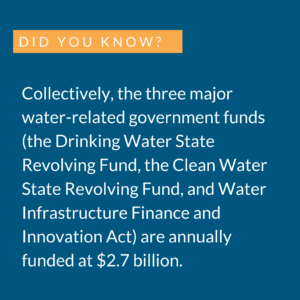 Much of the funding available through grants in the 1970s established and improved water and wastewater systems. In the 1980s, the emphasis switched from grants to loans through the USDA, and federal water infrastructure funding as a whole decreased. In 1977, 63% of total capital spending for water and wastewater systems came from federal agencies. Today, it’s less than 9%. Costs fall primarily on state and local governments.
Much of the funding available through grants in the 1970s established and improved water and wastewater systems. In the 1980s, the emphasis switched from grants to loans through the USDA, and federal water infrastructure funding as a whole decreased. In 1977, 63% of total capital spending for water and wastewater systems came from federal agencies. Today, it’s less than 9%. Costs fall primarily on state and local governments.
State & Local
“Drinking water and wastewater utilities are highly regulated entities whose primary goals are to meet regulatory requirements for protecting public health and the environment and to provide services for reasonable and fair rates.”
Of the $100 billion in federal infrastructure spending, 70% is in the form of grants to state and local governments. This includes:
- Direct federal credit programs (when the federal government lends money directly to state and local governments
- Tax-exempt bonds and credits
- State revolving funds and infrastructure banks (created and operated by state governments and funded primarily by grants from the federal government to provide assistance in the form of loans and credit lines for projects).
The EPA provides multiple state grants as part of the Clean Water State Revolving Funds, which states use to make loans to local communities for wastewater projects, and as part of the State Drinking Water State Revolving Funds, which states use to provide loans and other assistance to public water systems to comply with federal drinking water rules. The allotment for each state is need-based. The median loan size is $1 million, and states provide a 20% funding match.
Even with these sources, operation and maintenance costs continue to grow and outpace available funding. Systems exceeding their lifespans become costlier to operate and maintain. Local utilities cover almost all operation and maintenance costs; the federal government’s share of capital and operation and maintenance investment fell from 31% in 1977 to 4% in 2017.
The primary means for funding water infrastructure is user fees from water bills, so a utility’s ability to cover costs depends on the financial well-being of its customers. Water bill debts are widespread, but smaller and less affluent communities are at particular a disadvantage, as upgrading, expanding, and replacing water infrastructure would mean increasing water rates. On top of this, many small community water systems lack technical, managerial, and financial capacity and expertise.
Only 21% of all U.S. utilities report being able to fully cover the cost of providing drinking water services. Only 30% of rural utilities said they could continue to cover all system costs for another year if pandemic-induced revenue losses continue. More than 40% of these systems rely on only one full-time operator or on part-time staff, operators, or volunteers. Little COVID-19 emergency federal assistance has flowed to the water sector.
Comprehensive information on water systems at the state and local level is also difficult to come by, even though Section 2013 of America’s Water Infrastructure Act of 2018 (AWIA) “requires community water systems that serve more than 3,300 people to complete a risk and resilience assessment and develop an emergency response plan.” In New Jersey, the Jersey Water Check website, which went live in March 2021, is believed to be the first of its kind in the U.S. that consolidates information on the state’s water systems and whether they meet industry standards. The website was developed by Jersey Water Works, a 600+ member collaborative dedicated to renewing New Jersey’s drinking water and wastewater infrastructure.
Visit the EPA’s State Water Facts to see how water is used in each state. Utilities Connection: State Water & Wastewater Utility breaks down all the different utilities in each state.
Tribes
The U.S. government recognizes tribes “as sovereign nations with legal rights to the water resources in their territories,” but tribes do not have the same resources as state and local governments. For example, tribes cannot raise money through property taxes. Limited revenue streams are compounded by inadequate infrastructure, legacy contaminants, and insufficient technical expertise. Reporting by The Guardian adds that federal grants are too small to be effective, and that tribes are not often consulted in water decision-making.
Private Sector
Historically, the private sector has excelled at identifying problems, coordinating investment, motivating government, and finding creative solutions the government does not fund. The private sector “has the capacity to design and pilot new technologies to ensure that they are safe and effective, and they can work to build economies of scale that lower the costs of new technologies, making them more accessible.”
Philanthropy can also ease costs; for example, in rural communities with little infrastructure, philanthropic investment in services can bring down the cost per connection for services like water and sewer lines, which can make state or local investment more feasible. Many global Water, Sanitation, and Hygiene (WASH) organizations are based in the US, although most focus on international water access rather than domestic needs.
There are also a number of partnerships across sectors in the U.S. The U.S. Water Alliance is a membership of water providers, public officials, business leaders, agricultural interests, environmental organizations, community leaders, and policy organizations. The Rural Community Assistance Partnership is a national network of nonprofit organizations working to provide technical assistance, training, resources, and support to rural communities in the U.S. The Global Environment & Technical Foundation, which operates internationally and in the U.S. in coordination with the U.S. Water Partnership, fosters partnerships between businesses, governments, and civil society to design, develop, and implement sustainable water solutions.
The private sector is also a source of capital. The Water Finance Exchange is a nonprofit platform that was created by water and finance professionals to develop and fund long-term community-based water projects. Water sustainability funds are growing in popularity thanks to emphasis on environmental, sustainability, and governance (ESG – see The Policy Circle’s Impact Investing brief for more on this). The Wall Street Journal reports that investors “are directing a portion of their investments to funds that focus on themes such as water risks associated with pollution and climate change, and other issues that can jeopardize access to fresh water and the ability to meet human and ecological water demand.”
Susan Story, CEO at American Water Works, discusses what needs to be done for water infrastructure and who needs to do it (5 min):
Challenges & Areas for Reform
Access & Affordability
The U.S. Census Bureau’s American Community Survey (ACS) is the only national data set on water access, but is likely incomplete. The Census Bureau only asks about access to water, not about function or affordability. Additionally, the populations that are most difficult to count in the Census (lower-income, people who do not speak English) are considered to be the most likely to have water access issues, so many may be missed in the count. Finally, the questions on wastewater were removed from the ACS after 1990, leaving another data gap.
Affordability can also impact access to water. An analysis of 12 U.S. cities shows the combined price of water and sewage increased by an average of 80% between 2010 and 2018. In California, debt owed on water bills hit $1 billion in 2021, with at least 1.6 million households (one in eight) behind on payments, according to the state water board survey. On the other side of the country in Virginia, more than half a million households are behind on water bills, owing a total of almost $90 million to municipal utilities. The EPA standard for affordability is that households spend no more than 2% on drinking water and 4.5% of median household income on both drinking water and wastewater services.
Many utilities are in a catch-22 scenario: “they are operating at a deficit and need to raise rates to reflect the true cost of water while being reluctant to raise rates because their lowest-income ratepayers cannot absorb the additional cost.” Several utilities have developed customer assistance programs that “use bill discounts, flexible terms, special rate structures, and other means in an effort to help financially constrained customers maintain access to water systems.” Many others require technical assistance to help them create programs that are legally and regulatory compliant, and also help educate consumers about the programs. This is one reason as to why it is essential for individuals to be aware of their utilities and the charges on their utility bill.
Water Access Wars
Water rights vary by state along regional lines, with the eastern U.S. following a riparian doctrine of water use and the western U.S. following a prior appropriation approach to water rights. Under a riparian doctrine, people who own property adjacent to a river or lake have the right to use the water. Under the western U.S.’s prior appropriation doctrine, rights are determined by priority or beneficial use, meaning the first person to use or divert water for beneficial use can acquire the rights; this system emerged from the need to divert water away from rivers for economic reasons like mining and ranching.
A watershed, or drainage basin, is an area of land where all precipitation and runoff flows into a single lake, river, or other body of water. Because watershed boundaries do not overlap with political boundaries, interstate cooperation is necessary to manage water usage and water pollution among upstream and downstream stakeholders within a river basin.
For decades, Alabama, Florida, and Georgia have battled over the future allocation of water in two major river basins. The river systems originate in Georgia, but both Alabama and Florida downstream have concerns about their access for fishing industries and power generation. Several lawsuits about the water rights are pending in lower courts, and one case from Florida even made it to the Supreme Court.
Private sector involvement sometimes adds to the tension. Environmentalists have long accused Nestlé “of draining water supplies at the expense of local communities and ecosystems.” A 2017 investigation by the State of California found Nestlé had claims to 2.3 million gallons of water but took 58 million in 2020, meaning Nestlé took 25 times as much water than it was allotted. Similar battles with water bottle companies are going on in Oregon, Pennsylvania, Maine, Michigan, Washington, and Montana, with bills in place to restrict bottling or place taxes on the industry.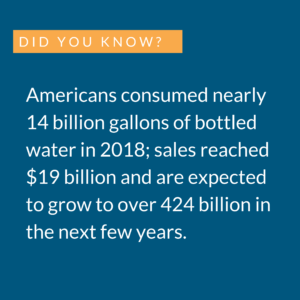
Most bottled water sold in the U.S. comes from the same sources that supply tap water. This means that companies like Coca Cola’s Dasani purchase, treat, and bottle municipal water before selling it at a mark-up to consumers. Consumer advocates claim this means that bottlers rely on infrastructure that is paid for by local taxpayers, so “the companies’ business is subsidized by the public”. Others add these businesses are not held to the same standard as residents; in Detroit, the policy (prior to the coronavirus pandemic) was to shut water off to residents if they fell $150 behind on their water bills, but the policy never applied to bottlers in Detroit even though they had thousands of dollars in past-due water bills.
Water-Energy Nexus
The Water-Energy nexus refers to the intersection of resources. Meeting energy needs “requires water… for mining, fuel production, hydropower, and power plant cooling, and energy is needed for pumping, treatment, and distribution of water and for collection, treatment, and discharge of wastewater.“ Many also add food to this equation, because water is essential to produce both food and energy. Given long-term global trends such as population growth, urbanization, changing diet, economic growth, and climate change, these resource tradeoffs and complications are only expected to intensify with growing demand for water, food, and energy.
These critical domains are inextricably linked, as noted by Federal Bureau of Investigation Director J. Edgar Hoover in 1941 during World War II. He said, “‘it has long been recognized that among public utilities, water supply facilities offer a particularly vulnerable point of attack to the foreign agent, due to the strategic position they occupy in keeping the wheels of industry turning and in preserving the health and morale of the American populace.’” Today this is just as true; one critical infrastructure survey indicated 75% of all U.S. critical infrastructure would be directly impacted if a continuous supply of treated water was interrupted or lost.
Energy Cost and Reliability
At drinking and wastewater plants, energy is the second-highest budget item after labor costs. Additionally, energy used in the water sector is projected to more than double between 2020 and 2040 due to increasing demand to treat wastewater and drinking water. Energy used for water is a function of numerous variables, including water source (surface vs. groundwater); treatment based on intended use, and distribution (local vs long distance).
Water used in the energy industry is the other side of the equation. Thermoelectric power plants use fossil fuels to boil water for steam that turns turbines and generates electricity. Then, the steam has to be cooled with more water. Water is also needed for resource extraction and processing, and for waste disposal. Fossil fuel production, biofuel production, and fracking are all highly water intensive. Less water-intensive energy sources, including wind and geothermal, are still a long way off from being able to supply considerable energy needs.
One major issue at the center of the water-energy nexus is the “lack of coherence and coordination between water and energy policies, planning, and decision-making roles. Energy and water decisions have historically been made independently of each other,” with energy planners assuming they’ll have the water they need and water planners assuming they’ll have the energy they need with little communication between the two sectors.
Agriculture
Besides thermoelectric power, agriculture and irrigation are the largest users of freshwater resources in the U.S. This is mainly due to the volume of demand for food to feed a growing population; almost 40% of all water usage in the U.S. is for agriculture. However, a surprising amount in the U.S. does go to watering lawns. Nationwide, the EPA estimates landscape irrigation accounts for almost one-third of all residential water use, about 9 billion gallons per day. The following video breaks down how lawns became one of the largest irrigated crops in the U.S. (4 min):
The effects of water on the food supply chain are apparent in California, which produces one-third of U.S. vegetables and two-thirds of U.S. fruits and nuts. Due to drought conditions that have carried on for years, California’s food and agriculture secretary Karen Ross said by 2021 she expected at least 500,000 acres of farmland to not be used for farming. All of this impacts food supplies and drives up prices.
For example, California’s $6 billion almond industry produces 80% of the world’s almonds. The region’s dry climate and reliable irrigation system created the perfect conditions; between 1995 and 2020, almond production increased from 270 million pounds to 3.1 billion pounds, and land planted with almond trees increased from 756 square miles to 2,500 square miles. But water has been scarce in the drought conditions and almonds require water year-round, forcing farmers to leave fields fallow to switch to higher-value crops that require less water. For 2021, one-third of California almond orchards are in areas with unreliable water supplies.
Even beyond California in areas with more water resources, many methods employed by the agricultural industry are not the most water-conscious. Soil can hold eight times more water than rivers, but common plowing and cropping methods can cause soil erosion. Additionally, wetlands that can capture, store, and purify runoff are often sacrificed for crop expansion, which worsens floods and droughts and results in large quantities of chemicals from farm fertilizers draining into rivers and streams.
For example, nitrogen and phosphorous enter rivers via runoff of fertilizers and soil erosion. The addition of these nutrients tips a delicate balance that can result in algae blooms that alter food chains and deplete oxygen in water ecosystems. In the U.S., this has resulted in a dead zone – an area of hypoxic (less than 2 ppm dissolved oxygen) water – at the mouth of the Mississippi River in the Gulf of Mexico that is one of the largest in the world.
More research, development, and implementation along the agrifood chain may help reduce the depletion of groundwater for agriculture. These include technologies and methods that can save water, including precision irrigation, drip irrigation, soil moisture sensors, and planting drought-resistant crops or cover crops.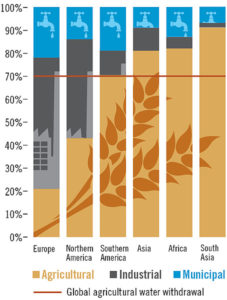
In Verde, Arizona, farmers used to irrigate fields by diverting most of the local river flow into a ditch system that would deliver water to farmlands. This system left over five miles of river almost dry. Hydrologists teamed up with local irrigators to work out solutions, including the installation of a solar-powered irrigation system that helped irrigators take only the water they needed and leave the rest for the river. The community engagement sparked more creative solutions; farmers, conservationists, and corporations in the area (including Intel and REI) invested in a local barley malting facility that supplies Arizona craft breweries to motivate farmers to plant barley, which requires less summertime irrigation than other crops.
Investing in Water
Economic forecasts estimate investing in water infrastructure could add $4.5 trillion in GDP over the next two decades as households and businesses enjoy the benefits of water reliability and water-reliant industries increase their productivity and efficiency. It is also estimated to create 800,000 new jobs by 2039, mostly in construction and professional services, with additional wages adding $2.8 trillion in additional disposable income over the next 20 years.
Skilled Workforce
Investing in the water workforce may be critical for water infrastructure, as roughly one-third of the water workforce is eligible to retire in the next 10 years. The EPA’s Water Sector Workforce Initiative focuses secondary and post-secondary training programs; collaboration with utilities, utility associations, tribes, and states in an attempt to modernize the water workforce. The USDA Rural Development Water and Environmental Program also has technical assistance and training programs. Most states also have programs; search on your state’s or municipality’s website.
Water Loss
Investing in water could mitigate the estimated $2.6 trillion in losses due to service disruptions and overflows. In 2019, disruptions and flooding cost households an estimated $2 billion and contaminated water resulted in $262 million in healthcare costs.
An estimated 47% of maintenance work by utilities is reactive and done only as systems fail, rather than proactively to prevent crises such as flooding and breaks. For this reason, many utilities do not have preventative asset management programs, tools, and techniques that could help evaluate infrastructure conditions and risks. Smart water technologies, such those provided by Logistec’s Altra water technologies, include leak detection systems, seismic resilient pipes, water quality monitoring, and real-time data sensors. These technologies can improve water quality and eliminate loss, but are costly; many utilities, particularly ones in low-income communities with fewer resources, may not be able to afford them.
System Innovation
Current regulatory and funding frameworks tend to favor centralized infrastructure, but many areas in need are the communities that are too small and remote to be supplied by centralized water systems, or the communities are in environments that make it prohibitively expensive to develop such a system. The U.S. Water Alliance points out that there are few options for service delivery and management “that are somewhere in-between municipal utilities and individual systems.” This can include small-scale wastewater systems that serve clusters of homes, or community-run collectives that deliver treated water to households.
Application and reporting processes for small systems are notoriously complicated, and they lack the access to government funding and technical expertise that is available to community water systems. For example, the Water Infrastructure Finance and Innovation Act of 2014 put in place a federal credit program administered by the EPA for water and wastewater infrastructure projects conducted by corporations, trusts, and local, state, and tribal governments. The program tends to be for larger projects, so one of the major concerns is that smaller projects do not benefit.
The USDA does have a Rural Development Household Water Well System Grant Program, but the main funding and regulatory structures “have a blind spot when it comes to domestic wells and septic systems.” Owners are responsible for these systems, regulations vary from state to state, and it is often unclear which state agency is responsible for overseeing them. Setting standards and providing technical assistance to ensure small-scale and decentralized systems are appropriately staffed and maintained could help fill the gaps among these communities.
Local Solutions
Consolidating systems is another solution many smaller communities are trying. Over half of all community drinking water systems serve 500 people or fewer. These small systems often lack the technical, managerial, and financial capacity to provide services due to declining funding, small revenue bases, and understaffing. But, they may be able to pool resources by working together. In Kentucky, for example, the Logan Todd Regional Water Commission formed after the consolidation of 12 utilities. The new central water treatment facility lowered costs and managerial burdens, and was reliable enough to attract new businesses to the county. State-level policies encouraged such regionalization, and a USDA loan provided funding, showing the importance of cross-sector partnerships along with community involvement.
Meaningful participation from community members can help determine needs and opportunities, and instill trust. Especially in light of major headlines about cities like Flint, Michigan and Newark, New Jersey, there has been a crisis of public perception of tap water. If community members can serve on local water boards and associations, they could gain a better understanding of how water systems function in their communities, and what needs to be done.
Long-term Solutions
Coordination
Although advanced treatment techniques and technologies can mitigate challenges from lead to bacteria to chemicals, they will not solve all problems related to aging water pipes and treatment facilities. For example, corrosion control treatment measures are effective, but are temporary solutions that are not cost-effective in the long term. Long-term solutions may involve better coordination between local, state, and federal governments to enhance data collection, assess threats more accurately, and implement solutions more effectively. Collaboration between federal agencies and state and local water managers, who best understand local challenges, offers the greatest success in securing water resources for communities and economies.
Desalination is the process of taking ocean or brackish water with lots of salt and treating it to drinking standards. Costs are half of what they once were, although they are still twice as expensive as extracted freshwater.
Another way to “make” water is through recycling, or reusing “treated wastewater and stormwater for agricultural, non-potable, or even potable uses” as an alternative to traditional water sources. The 2.5 million residents of Orange County recycle nearly all of their wastewater. In combination with groundwater reserves, recycling water supplies residents with 75% of their drinking water needs. On the whole, the United States only recycles 6% of its water, but infrastructure and regulatory reforms can unlock more capacity; these changes in Israel have helped the country recycle almost 90% of its wastewater to address water scarcity issues.
Kite & Key Media dives deeper into desalination and water recycling (7 min):
While processes such as recycling and desalination can provide “an alternative source of water that can be more reliable than traditional raw water sources,” conservation and efficiency measures still tend to be “the most cost-effective and environmentally sound ways to meet new water demands.” The expense of newer processes is a drawback. If the cost of producing water increases, then the cost of everything involving water would also be higher, meaning costs of consumer goods would skyrocket. This is the question at the heart of navigating the economics of water: how do we put a value on an invaluable resource, while still ensuring access for all?
The U.S. is not the only country experiencing challenges with water. See this explainer from Netflix for world water challenges (18 min):
Conclusion
Proactive measures addressing the future state of our nation’s water is the key to staving off a crisis. Knowledge of present and future challenges is key to prevent further complications. Especially with a resource so critical to human life, why wait for a crisis to understand how the industry functions and who the key influencers are?
Ways to Get Involved/What You Can Do
Measure: Find out what your state and district are doing about water infrastructure.
- Do you know the state of water infrastructure in your community or state?
- Look at your water bill for your home or business. Do you understand it?
- How does water pricing in your state compare to others?
- Is your water from a public system, or do you have a private system?
- Search the EPA’s Safe Drinking Water Information System (SDWIS) for public water systems by country, city, or population.
- Where does your drinking water come from?
- Is your region prone to flooding or drought?
- Is there a task force on water in your municipality, or does one need to be formed?
Identify: Who are the influencers in your state, county, or community? Learn about their priorities and consider how to contact them, including elected officials, attorneys general, law enforcement, boards of education, public utility boards, city councils, journalists, media outlets, community organizations, and local businesses.
- Who performs maintenance, upgrades, and quality control processes?
- Who are the members of coalitions or utility boards in your state?
- What steps have your state’s or community’s elected and appointed officials taken?
Reach out: You are a catalyst. Finding a common cause is a great opportunity to develop relationships with people who may be outside of your immediate network. All it takes is a small team of two or three people to set a path for real improvement. The Policy Circle is your platform to convene with experts you want to hear from.
- Find allies in your community or in nearby towns and elsewhere in the state.
- Foster collaborative relationships with community organizations, school boards, local businesses, law enforcement, local hospitals, and any other community members affected by water systems.
Plan: Set some milestones based on your state’s legislative calendar.
- Don’t hesitate to contact The Policy Circle team, communications@thepolicycircle.org, for connections to the broader network, advice, insights on how to build rapport with policy makers and establish yourself as a civic leader.
Execute: Give it your best shot. You can:
- Determine the budget and staff salary for your local department of water and sanitation.
- Show up at local meetings on water, or at a public works commission.
- Ask about infrastructure maintenance or conservation projects
- Calculate your own Water Footprint.
- Choose an area of water to focus on:
- Improving infrastructure and limiting water loss
- Water conservation and recycling
- Water access and affordability
- Water quality
- Energy costs and reliability in relation to water
- Cybersecurity and security of water infrastructure
Working with others, you may create something great for your community. Here are some tools to learn how to contact your representatives and write an op-ed.
Additional Resources
- Water Finance Exchange – nonprofit platform created by water & finance professionals to develop and fund community-based water projects; community-based platform to facilitate the financing of long-term solutions for local water challenges
- UN World Water Development Report and Drinking Water Fact Sheet
- River Runner: Where a drop of water anywhere in the U.S. ends up
- US Drought Monitor
- National Oceanographic and Atmospheric Administration
- Water Resources Institute: Water Risk
- Circle of Blue: Price of Water
- Environmental Working Group’s Tap Water Contamination Index: enter your ZIP code or State to find out what’s in your tap water
